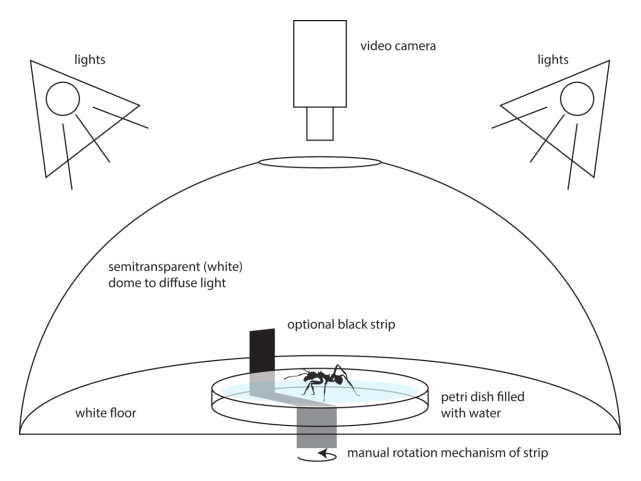Innate turning preference of leaf-cutting ants in the absence of external orientation cues

Many ants use a combination of cues for orientation but how do ants find their way when all external cues are suppressed? Do they walk in a random way or are their movements spatially oriented? Here we show for the first time that leaf-cutting ants (Acromyrmex lundii) have an innate preference of turning counter-clockwise (left) when external cues are precluded. We demonstrated this by allowing individual ants to run freely on the water surface of a newly-developed treadmill. The surface tension supported medium-sized workers but effectively prevented ants from reaching the wall of the vessel, important to avoid wall-following behaviour (thigmotaxis). Most ants ran for minutes on the spot but also slowly turned counter-clockwise in the absence of visual cues. Reconstructing the effectively walked path revealed a looping pattern which could be interpreted as a search strategy. A similar turning bias was shown for groups of ants in a symmetrical Y-maze where twice as many ants chose the left branch in the absence of optical cues. Wall-following behaviour was tested by inserting a coiled tube before the Y-fork. When ants traversed a left-coiled tube, more ants chose the left box and vice versa. Adding visual cues in form of vertical black strips either outside the treadmill or on one branch of the Y-maze led to oriented walks towards the strips. It is suggested that both, the turning bias and the wall-following are employed as search strategies for an unknown environment which can be overridden by visual cues.
| Author(s): | Endlein, Thomas and Sitti, Metin |
| Journal: | Journal of Experimental Biology |
| Volume: | 221 |
| Number (issue): | 14 |
| Pages: | jeb177006 |
| Year: | 2018 |
| Month: | June |
| Day: | 7 |
| Publisher: | The Company of Biologists Ltd |
| Bibtex Type: | Article (article) |
| DOI: | 10.1242/jeb.177006 |
| URL: | http://jeb.biologists.org/content/early/2018/06/01/jeb.177006 |
| Electronic Archiving: | grant_archive |
| Eprint: | http://jeb.biologists.org/content/early/2018/06/01/jeb.177006.full.pdf |
BibTex
@article{Endleinjeb.177006,
title = {Innate turning preference of leaf-cutting ants in the absence of external orientation cues},
journal = {Journal of Experimental Biology},
abstract = {Many ants use a combination of cues for orientation but how do ants find their way when all external cues are suppressed? Do they walk in a random way or are their movements spatially oriented? Here we show for the first time that leaf-cutting ants (Acromyrmex lundii) have an innate preference of turning counter-clockwise (left) when external cues are precluded. We demonstrated this by allowing individual ants to run freely on the water surface of a newly-developed treadmill. The surface tension supported medium-sized workers but effectively prevented ants from reaching the wall of the vessel, important to avoid wall-following behaviour (thigmotaxis). Most ants ran for minutes on the spot but also slowly turned counter-clockwise in the absence of visual cues. Reconstructing the effectively walked path revealed a looping pattern which could be interpreted as a search strategy. A similar turning bias was shown for groups of ants in a symmetrical Y-maze where twice as many ants chose the left branch in the absence of optical cues. Wall-following behaviour was tested by inserting a coiled tube before the Y-fork. When ants traversed a left-coiled tube, more ants chose the left box and vice versa. Adding visual cues in form of vertical black strips either outside the treadmill or on one branch of the Y-maze led to oriented walks towards the strips. It is suggested that both, the turning bias and the wall-following are employed as search strategies for an unknown environment which can be overridden by visual cues.},
volume = {221},
number = {14},
pages = {jeb177006},
publisher = {The Company of Biologists Ltd},
month = jun,
year = {2018},
slug = {endleinjeb-177006},
author = {Endlein, Thomas and Sitti, Metin},
eprint = {http://jeb.biologists.org/content/early/2018/06/01/jeb.177006.full.pdf},
url = {http://jeb.biologists.org/content/early/2018/06/01/jeb.177006},
month_numeric = {6}
}

